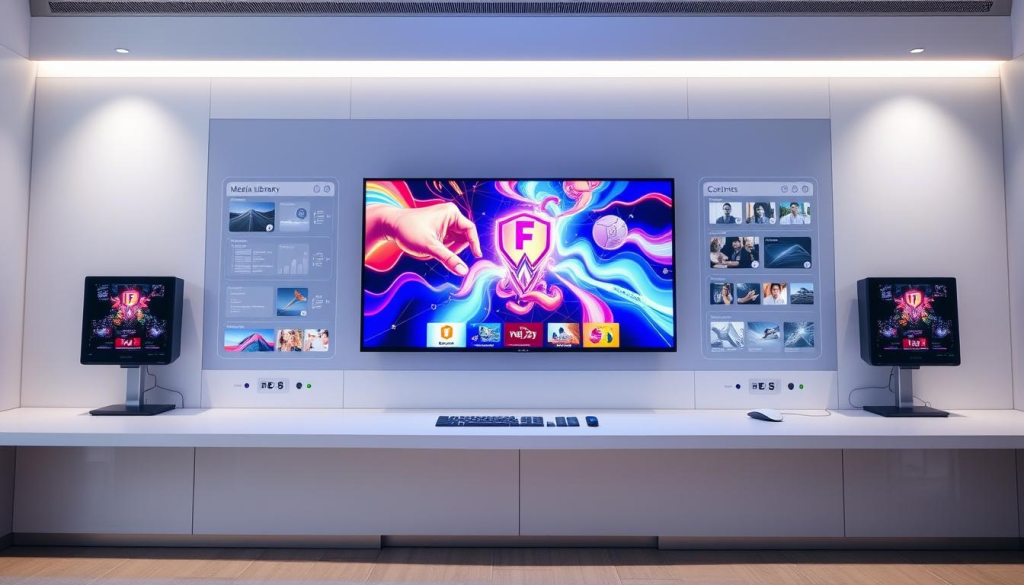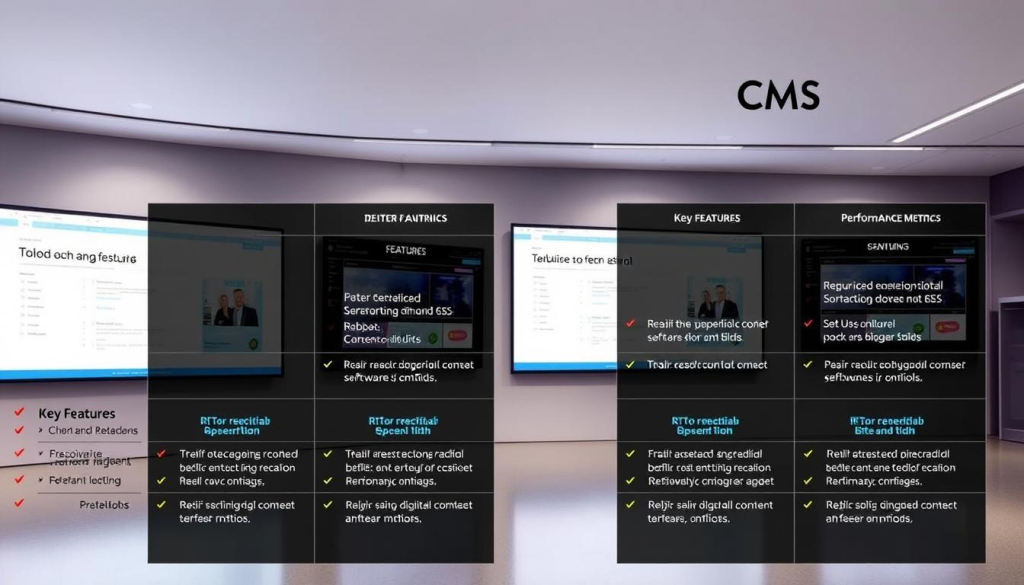In today’s world, finding new ways to connect with people is more important than ever. Digital signage CMS is a key tool for businesses in many fields. It’s valued at USD 26.76 billion in 2023 and is growing fast, at 8.1% from 2024 to 2030.
This growth shows how important it is for sectors like retail, hospitality, and healthcare. A good digital signage CMS helps brands talk to their customers better.
More and more businesses see how digital signage can change things. About 75% of people say they notice brands more when they see them on screens. So, finding the best digital signage software is a must.
Marketers say digital signage makes customers happier, and 62% of companies sell more because of it. So, it’s key to look at the top digital signage platforms to get the most out of this tech.

Key Takeaways
- Digital signage CMS is key for managing content displayed on screens.
- The digital signage market is expected to grow significantly, indicating robust demand.
- Engagement with brands increases for 75% of consumers through digital signage.
- 80% of marketers report enhanced customer experience through digital signage.
- 62% of companies see increased sales attributed to digital signage.
- Cloud-based digital signage solutions offer immediate access to content dashboards.
- User-friendly CMS reduces training time and supports quicker content deployment.
Introduction to Digital Signage and CMS
Digital signage is a powerful tool for communication. It uses electronic displays to show multimedia content like videos, images, and text. A big 63% of people notice these screens right away.
Businesses use digital signage to replace old flyers and posters. This makes displays more engaging and can show endless messages.
A content management system (CMS) is key for digital signage. It lets users create, schedule, and manage content easily. The cost for digital signage starts with hundreds of dollars for hardware like TVs, priced around $300.
Monthly software costs can be as low as $20. This makes digital signage affordable for many businesses.
Digital signage systems have four main parts: a plan, CMS software, hardware, and great content. Users can pick from cloud-based or on-premise CMS platforms. This lets companies manage different content types, like animations and videos, to keep people interested.
Managing content is easier with a digital signage CMS. It offers tools for remote monitoring, analytics, and scheduling. Users can set how long content stays up and how it changes. This helps keep branding consistent while allowing teams to customize their displays.
Why Choose a Digital Signage CMS?
Businesses want to improve communication and engage customers better. Choosing a digital signage CMS brings big benefits, like better content management and sharing. It lets companies show messages at the right times, making a bigger impact.
Remote management makes things easier, letting users control displays from anywhere. This boosts efficiency and helps respond quickly to changes. For companies with many locations, a good CMS is key to keeping the brand consistent.
Top digital signage software offers real-time updates and data integration. This means you can show live news and social media feeds. It keeps content fresh and engaging. Plus, it has security features like user permissions to protect content.
A digital signage CMS is great for big networks with different content needs. It can update 1,000 players at once, helping keep messages consistent. This is important for companies with complex messaging needs.
Using templates and design tools in digital signage software makes creating content easier. It doesn’t require advanced graphic design skills. In short, choosing a digital signage CMS improves operations, engagement, and content management.
Digital Signage CMS: Key Features to Consider
Choosing a digital signage CMS means looking at its key features. A user-friendly interface makes it easy to manage content for any business size. Scalability is also key, as companies grow their digital signage networks.
Being able to support multiple devices is a big plus. This lets businesses show content on kiosks, tablets, and smartphones. Real-time updates ensure the latest info reaches everyone quickly.
Analytics and audience metrics boost marketing efforts. They help businesses understand how well content performs and when to show it. Regular updates and A/B testing keep audiences engaged.
Remote management tools like proof-of-play and device health monitoring are handy. They help manage digital signage across many locations. Security features like two-factor authentication and encrypted data keep information safe.
Investing in digital signage software can bring big benefits. The market is expected to hit $30.56 billion by 2028. Companies using these features will improve their messaging and connect better with their audience.
Benefits of Cloud-Based Digital Signage Solutions
Cloud-based digital signage solutions offer big advantages for how companies talk to their audience. They let you manage content from anywhere, making things run smoother. This is super helpful for businesses with many locations, as it ensures everyone gets the latest info fast.
Another great thing about cloud tech for signs is how easy it scales. You can start small or grow big without spending a lot on hardware. This means you can change your digital signage as your needs do.
Cost savings are a big reason to go cloud. You save on hardware and upkeep, freeing up money for other things. Plus, you only pay for what you use, avoiding big server bills.
Security is key in today’s digital world. Top cloud providers use strong security to keep your data safe. They use things like encryption and two-factor auth to protect your content.
Cloud solutions also make it easier to grab people’s attention. They let you mix different types of media to boost your message. Plus, interactive features like wayfinding make places easier to navigate, helping both visitors and staff.

| Feature | Advantages |
|---|---|
| Remote Accessibility | Update content from any location, improving efficiency. |
| Real-Time Updates | Timely communication for announcements and alerts. |
| Scalability | Easily expand to multiple screens without infrastructure costs. |
| Cost Effectiveness | Reduce upfront costs and maintenance fees. |
| Advanced Security | Protect sensitive data with encryption and authentication. |
| Dynamic Display | Integrate various formats for enhanced engagement. |
| Interactive Features | Wayfinding and visitor management to improve navigation. |
Top Digital Signage Platforms in 2025
In 2025, digital signage technology will see big changes. BrightSign, CAYIN Technology, and friendlyway are leading the way. They offer innovative features for different business needs, improving communication and engagement.
BrightSign is known for its BrightSignOS. It powers millions of players worldwide. It’s reliable, secure, and energy-efficient, making it great for retail, healthcare, and education.
CAYIN Technology stands out for its media flexibility. It supports 4K video and HTML5. Its GO CAYIN cloud platform lets businesses manage content remotely, perfect for hospitality and corporate settings.
Friendlyway has deployed its solutions in 25,000 devices across 70 countries. It serves various sectors like tourism, real estate, and manufacturing. This shows friendlyway’s adaptability and commitment to digital solutions.
Here’s a table comparing some key features of these top platforms:
| Platform | Core Features | Free Trial | User Rating |
|---|---|---|---|
| BrightSign | Reliable OS, Energy-efficient management | 30-day free trial | 3.4/5 (G2) |
| CAYIN Technology | Supports 4K & HTML5, Centralized cloud control | N/A | N/A |
| friendlyway | Global deployment, Flexibility across verticals | N/A | N/A |
| Mandoe | AI-generated content, Access to templates | N/A | N/A |
| Omnivex | Real-time data consolidation, Cross-device compatibility | N/A | N/A |
When choosing digital signage, these top platforms are worth considering. They offer solutions that boost display capabilities and efficiency.
Comparative Analysis of Leading Digital Signage CMS Solutions
Looking at top digital signage CMS solutions shows their strengths and features. BrightSign is great for big companies because it focuses on security and being green. Mandoe is good for those who want easy content making and managing, thanks to its AI tools.
Omnivex is known for its detailed analytics, perfect for businesses that value data. Each platform has its own set of features. This lets companies pick what fits their needs and budget.

| Platform | Key Features | Target Audience | Pricing |
|---|---|---|---|
| BrightSign | High security, sustainability | Enterprises | Custom pricing based on needs |
| Mandoe | AI-driven content management | SMBs, Marketing Teams | Starting at $29/month |
| Omnivex | Advanced analytics tools | Data-focused businesses | Custom pricing |
| ScreenCloud | Scalability for enterprises | Large businesses | Rates vary based on displays |
| NoviSign | Engagement tracking, social media integration | Marketing agencies, Retailers | Starting at $10/month per display |
This analysis helps businesses understand each solution’s features and costs. It guides them in choosing the best digital signage for their needs. This way, they can improve communication and engagement with their audience.
User-Friendly Digital Signage Management Software
Choosing digital signage tools that are easy to use is key. Platforms like Navori Manager show how it’s done with their simple CMS. This software lets anyone create and share multimedia content without needing to be tech-savvy.
It has drag-and-drop tools and templates to make things easier. This boosts productivity and creativity.
Navori Manager works with almost all content types, so you don’t have to worry about converting files. It makes organizing content easy with channels, tags, or types. This helps teams work together better. It also has secure login options to protect your data.
It has advanced features for controlling content playback. You can make playlists to organize and schedule your signs. The software also tracks who’s watching and how they’re interacting with your signs.
It’s flexible and grows with your business. You can manage different content for different groups while keeping data safe. It follows strict security rules to protect your information.
Yodeck is great for starting with digital signage. It lets you set up displays in just three steps. You get hundreds of free templates to match your brand. Plus, it’s free for the first screen, perfect for small businesses.
Interactive Digital Signage Software: Engaging Audiences
Interactive digital signage software is changing how we engage with audiences. It uses tools like touchscreen displays and interactive kiosks. This makes viewing experiences more dynamic and interactive.
Customers now get to interact with content in new ways. They can take surveys, find product info, and more. This leads to higher satisfaction and stronger brand connections.
Navori Labs is a leader in this field. They offer software that combines interactive features with analytics. Their systems track viewer habits and adjust content in real-time.
This approach helps marketers tailor their messages. It ensures their content hits the mark with their audience. It also boosts engagement.
Features like QR codes add to the experience. They let users access extra content on their phones. This enriches the overall experience and builds loyalty.
As companies aim for deeper connections, interactive digital signage is key. It will continue to shape the future of customer engagement.
FAQ
What is digital signage CMS?
A digital signage content management system (CMS) is software for managing digital content on electronic signs. It makes updating content easy and timely. This boosts communication and engagement with viewers.
Why should businesses invest in digital signage solutions?
Investing in digital signage can increase customer engagement and foot traffic. With 60% of retailers planning to use it soon, it’s key for staying competitive.
What key features should I look for in a digital signage CMS?
Look for user-friendly interfaces, scalability, and support for many devices. Real-time updates and analytics are also important. AI for personalizing content based on viewer data is a plus.
What are the advantages of cloud-based digital signage solutions?
Cloud-based solutions offer remote management, scalability, and cost savings. They let you update signs instantly from anywhere. This makes customizing content across displays easy and affordable.
Which digital signage platforms are expected to lead in 2025?
BrightSign, CAYIN Technology, and friendlyway are expected to lead in 2025. They offer unique features like enhanced security and support for various media formats. This meets different business needs.
How do I compare different digital signage CMS solutions?
Compare by looking at their strengths and weaknesses. For example, BrightSign is strong in security, while Mandoe uses AI for content management. Omnivex focuses on analytics. Choose based on your needs and budget.
What makes digital signage management software user-friendly?
User-friendly software has drag-and-drop interfaces, pre-built templates, and simple designs. This lets non-techies easily add multimedia content. It makes using the software easy and quick to learn.
How does interactive digital signage software enhance audience engagement?
Interactive software turns viewers into participants with touchscreen displays and kiosks. It allows for interactions like product info and surveys. This boosts satisfaction and engagement with features like QR codes.